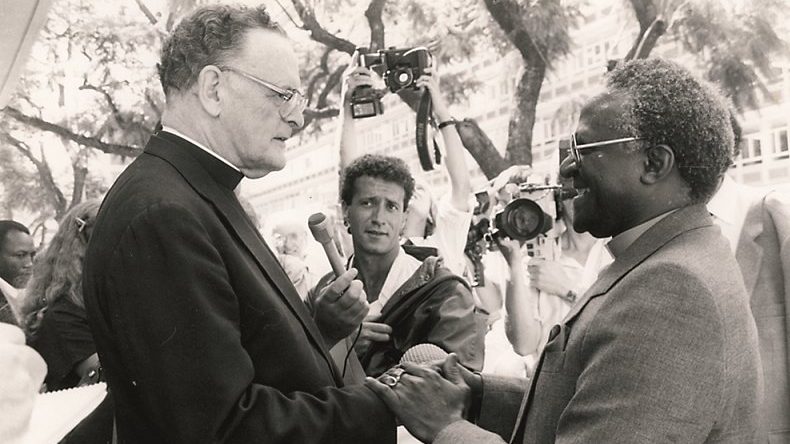Archbishop Desmond Tutu, who died Dec. 26, made his clerical career in the Anglican Church, but at one point, he is said to have contemplated the Catholic priesthood. Instead, he got married in a Catholic Church.
Born Oct. 7, 1931, in Klerksdorp as one of four children of Zachariah, a teacher, and Aletta, a domestic worker, Desmond Mpilo Tutu's first exposure to Christianity was in the African Methodist Episcopal Church that his parents attended. But he fell in love with Nomalizo Leah Shenxane, a Catholic. The two were married July 2, 1955, in the Catholic Church of Mary Queen of the Apostles in Johannesburg.
Oblate Father Jean Verot officiated. In the marriage register, kept in Latin, Father Verot noted that this was a "mixed marriage," listing Leah as a Catholic and Desmond a Protestant.
The two had four children together. The oldest, Trevor, was named after Anglican Father (later Archbishop) Trevor Huddleston, who had a great influence on Tutu. The second was named Thandeka Theresa Ursula; the two middle names were a nod to Leah's Catholic background. The family worshipped in St. Paul's Anglican Church, where Desmond was involved in several lay roles.
He found his vocation there and studied at St. Peter's Theology College in Johannesburg before he was ordained an Anglican priest in 1960. His final college report praised his exceptional skills and intelligence, but also noted that he "seemed to be suffering from a touch of 'Roman fever.'" The report recommended that "perhaps his bishop might do well to question him about that before ordination."
The apparent affliction of "Roman fever" insinuated that Tutu was exhibiting signs of subscribing to the beliefs and practices of the Catholic Church, as South African biographer John Allen noted in his 2006 biography of the archbishop, "Rabble-Rouser for Peace."
That flirtation with Catholic practices continued even after Archbishop Tutu had been made a bishop. When he was appointed secretary-general of the South African Council of Churches in 1978, he introduced staff prayer meetings, retreats and the like. His daily prayer routine remained one of disciplined devotion, including the Eucharist in the morning and the Angelus at noon, complete with the Hail Mary.
Archbishop Tutu had a great devotion to St. Thérèse of Lisieux, whose spirituality was rooted in prayer.
"As I am not part of the Catholic tradition, I think my interest in her indicates that she has an ecumenical appeal," he once said. "She encourages us to grasp the significance of retracting into oneself for inner peace, to seek solitude, silence and waiting, to be with God. It can't have been easy to reach such a prominent position in the church at a time when women were often seen rather than heard," he is quoted as saying in the 2018 book, "Beautiful Thoughts for Beautiful Minds" by John Scally.
Archbishop Tutu's social and political engagements were based on what he discerned to be the mandate of the Gospel. In that he followed in the path set by older Christian leaders, including Catholic Archbishop Denis Hurley of Durban, who in 1958 had pushed the Catholic Church to be the first ecclesial body to declare the racist apartheid system a "structural sin." Archbishop Tutu would later say that Archbishop Hurley, a man of tall build, was the giant "on whose shoulders we stood."
Archbishop Tutu visited the Pretoria court where Archbishop Hurley was charged in 1985 for revealing atrocities committed by the apartheid regime in what is now Namibia. From the dock, Archbishop Hurley did not address the court, but during breaks, he'd talk with supporters, jokingly inviting Archbishop Tutu and Leah to join him in the dock. Charges against Archbishop Hurley were dropped before the trial could even begin.
After becoming archbishop of Cape Town in 1985, Archbishop Tutu -- with Catholic Archbishop Stephen Naidoo and the Rev. Allan Boesak -- formed a trinity of church negotiators in defusing crises in Cape Town. After police shootings in Cape Town killed more than 20 people on election night in September 1989, Archbishop Tutu prayed intensely and unilaterally decided to call a protest march that started at St. George's Anglican Cathedral.
Put on the spot, newly elected President Frederick W. de Klerk allowed the march to go ahead. Some 35,000 "Rainbow People," as Archbishop Tutu dubbed them that day, took part. According to De Klerk, that march pushed apartheid over the cliff.
By then, Tutu had already been awarded the Nobel Peace Prize, in 1984. In 1987, he received a prestigious Catholic honor: the Pacem in Terris Award, named after St. John XXIII's landmark encyclical on peace on earth.

